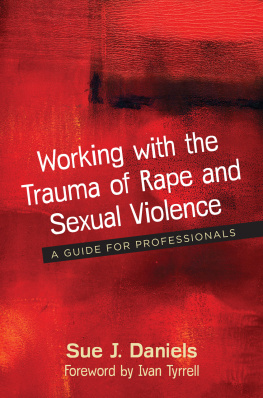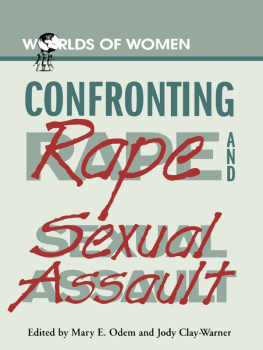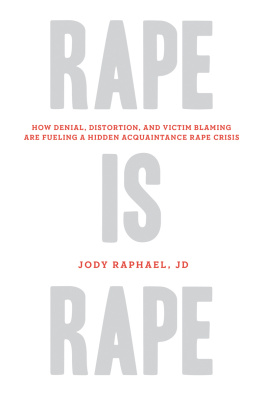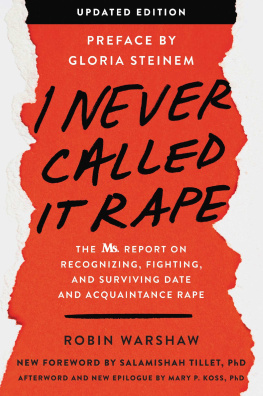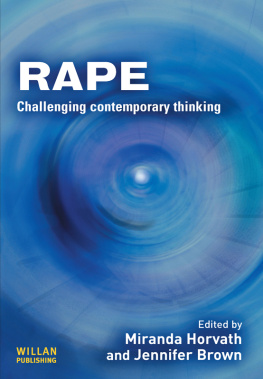THE VICTIM OF RAPE
THE
VICTIM
of
RAPE
INSTITUTIONAL REACTIONS
Lynda Lytle Holmstrom
Ann Wolbert Burgess
First published 1983 by Transaction Publishers
Published 2017 by Routledge
2 Park Square, Milton Park, Abingdon, Oxon OX14 4RN
711 Third Avenue, New York, NY 10017, USA
Routledge is an imprint of the Taylor & Francis Group, an informa business
All rights reserved. No part of this book may be reprinted or reproduced or utilised in any form or by any electronic, mechanical, or other means, now known or hereafter invented, including photocopying and recording, or in any information storage or retrieval system, without permission in writing from the publishers.
Notice:
Product or corporate names may be trademarks or registered trademarks, and are used only for identification and explanation without intent to infringe.
Library of Congress Catalog Number: 83-678
Library of Congress Cataloging-in-Publication Data
Holmstrom, Lynda Lytle.
The victim of rape
Reprint. Originally published: New York : Wiley, c1978.
Includes bibliographical references and index.
1. RapeMassachusettsBostonCase studies. 2. Rape victimsServices forMassachusettsBoston. I. Burgess, Ann
Wolbert. II. Title.
HV6568.B7H64 1983 362.8830974461 83-678
ISBN 0-87855-932-9
ISBN 13: 978-0-87855-932-9 (pbk)
To
Everett C. Hughes and Rose A. Godbout
mentors
Contents
Preface
Lynda Lytle Holmstrom and Ann Wolbeit Burgess
This book looks at how three major institutionspolice, hospital, and courtrespond to the rape victim and what impact this response has on victims. In our research, we followed a group of victims from the time they arrived at the emergency ward until the end of the legal process. Our data clearly show that rape does not end with the departure of the assailant. Instead, the institutional processing that occurs can be equally devastating. Those institutions that are to help victims can at the same time also further victimize them. Finding out what aspects cause further harm is essential. It is only by knowing what features are upsetting that we are in a position to provide support to victims and to recommend constructive change.
Research projects are guided by various assumptions and ours is no exception. Perhaps some of these should be made explicit here. First, we have a strong preference for seeing things firsthand. We thought it important to be where the action was. This led us to use participant observation as one of our main sources of information. We went to the emergency ward when victims were brought in, often in the middle of the night. We went to the courthouse and spent countless hours waiting and observing before the cases were called. We sat through the hearings and trials to hear the testimony word for word and watch the drama of the courtroom unfold. We also believe it is important to know what the situation means to the participants involved, to listen to what they have to say about their subjective experiences. Hence, our observations were complemented by many in-depth interviews, especially with victims.
Second, we believe in the value of interdisciplinary work. Our colleagueship began through a chance introduction that led to interdisciplinary teaching on the organization of health care. Later, when one of us (Holmstrom, a sociologist) became interested in rape, she approached the other (Burgess, a psychiatric nurse) for an exchange of ideas on how to study the problem. Burgess said that if a counseling component could be added to the research, she would be interested in being involved in the project. Thus, our research partnership came into being. Instructing each other in the relevant aspects of our respective fields has been an exciting venture.
Third, we believe in the importance of thinking through the policy implications of our research. Social science inquiry often is done simply for the contribution that it may make to the academic discipline. It seems important to us to look also at its practical relevance. Therefore, in our final chapter we make suggestions based on our data and our values for both immediate and long-term change. Our hope is that the book will be useful not only to academicians but also to the many people who presently are trying to promote a more humanistic response to the rape victim.
Acknowledgments
We are indebted above all else to the rape victims whose situations are analyzed in this book and who allowed us to be with them through a very difficult part of their lives. We also acknowledge the cooperation of the many physicians, nurses, social workers, police officers, assistant district attorneys, judges, and court officials with whom we came in contact and whose behavior we observed. We would like to be able to thank them by name, but privacy dictates that they remain anonymous both here and in the text of the book. Names of all victims and institutional personnel used in the case examples have been changed.
Special thanks are due to Anne G. Hargreaves, Executive Director of Nursing Services and Nursing Education, Department of Health and Hospitals, City of Boston, and Pamela MacLean Johansen, Assistant Director of Nursing, Emergency Services, Boston City Hospital for their assistance in arranging for our project to be based in the Emergency Services of Boston City Hospital.
Key people in the research design were the clerical personnel assigned to the accident floor and the pediatric walk-in service. It was their telephone call in the middle of the night that alerted us when a rape victim was admitted. We hereby thank Beatrice Crews, Sally Harper, Doris Jackson, Margery Jones, and Priscilla Sequira.
We thank the following student research assistants who helped us do library work; accompany victims to court; make telephone calls to the police, the courthouses, and the victims; and assist with the follow-up home interviews: Marie Beatini, Mary Terrio Burroughs, Linda Evans, Thomas S. Gary, Dianne Kenty, and Anna Laszlo.
We are grateful to the following people who volunteered their time to help in the huge job of gathering fieldwork data at the many courthouses: Helen Foley Barry, Donella Berry, Dorothy Ann Cain, Patricia Casey, Patricia Colpitis, Barbara Frates, Barbara Barth Frink, Marion Longo, Agnes Stumpf, and John N. Wolbert.
Boston College secretary Katherine Lydon must be cited for the innumerable telephone calls she made to ascertain the days and times of court sessions.
The librarians of the Boston College library system deserve our thanks: Mary L. Pekarski and Anne F. Lippman at the nursing library were especially helpful in locating works for us. The reference staffs of the law library and of Bapst, the main campus library, were highly efficient in tracking down references.
We thank the many people with whom we discussed aspects of the research and especially want to mention the following: Benedict S. Alper, Stephen T. Barry, F. Ross Holmstrom, Paula Goldman Leventman, Pamela A. Roby, and Stephen Schafer. We are especially grateful to colleagues who took the time to read and comment on selected portions of the manuscript: John D. Donovan, Sharlene J. N. Hesse, and David A. Karp (the courtroom scene); A. Nicholas Groth (civil commitment); Leslie Sebba and Leon S. Sheleff (alternative models of the criminal justice system); Barrie Thorne (linguistic strategies); and John B. Williamson (variables associated with legal outcome). The interpretations and conclusions presented are of course our own and the people to whom we are indebted should not be held responsible for any shortcomings in them.



